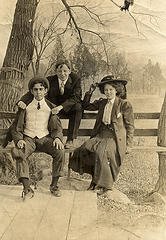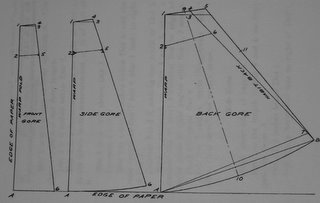
We've done it! A group of us are trying out a period sewing circle, to meet on the last Saturday of every other month. At this inaugural meeting, we'll talk about the varied nature of period sewing, think about what each of us would like to make, and I will show a portion of my antique clothing and period-inspired and period reproduction pieces.
Photo: Pauline in her walking skirt, circa 1911. Photo courtesy Big Brown House.Period-Inspired Skirts: A Fun Starting ProjectBecause many period-style skirts need fitting only at waist and sometimes hips, and because they're often made with straight seams,

they make a good starting project. Fashionable and wearable they can be, too. Who doesn't like a little swish around the ankles?
Without getting too deeply into fashion history, I can tell you that in years past the term "walking skirt" meant a skirt that was easy to wear for, well, walks and rambles, shopping and informal occasions like snipping flowers. Walking length skirts were normal for working clothes, too, when you expected to become grubby and needed to climb or kneel without the pretty appendage of a tail -- a train -- trailing behind you.
Photo: Dame Nellie Melba, 1909, in a skirt with quite a tail...er, train. From State Library of Queensland, Australia, uploaded to Flickr.Here's a video from 1904 with many shots of women in skirts of walking length: see how they move! (See also the post on
Edwardian Promenade about the clip.)

Here's an original walking skirt with felled seams. Functional and pretty! See the blog post "
Anatomy of a 1900-1911 Vintage White Heavy Cotton Skirt".
Some Skirt Options for Our CircleSense and Sensibility Patterns carries a pattern called the
Beatrix skirt, that was inspired by the skirts that Beatrix Potter lived in on her farm. The style dates to 1909 and depending on the fabric used and how you cut the waist and hem, and how you sew the seams can go from outdoorsy and functional to the elegant clinging line of that year, complete with a small train.

The skirt is fullish, but is not meant to flare out. Like most skirts of that year, it's composed of multiple gored panels: 9, in this case. The panels help shape the skirt around the body for a smoother line.
Photo: Outdoorsy version of the Beatrix skirt. Photo courtesy Sense and Sensibility patterns.
I've made this skirt several times and have
helped friends to make it too, and each time it's a fun process. There was the
dressy version, for instance, and now the version that will be incorporated into a
lingerie dress. For our purposes, the pattern is especially helpful because Jennie Chancey, the pattern designer, has posted
illustrated directions. What I can show is how the pattern can be altered and period techniques used to create different effects.
A 1911 Skirt That Flares More
You might also be interested in a
plain five-gore dress skirt from 1911. That year skirts flared out around the feet a bit more...the last year long skirts would do so. This pattern for this one comes from a high school textbook of the era called
Textbook on Domestic Art and must be drafted. You can download the entire book from Google and print out the pages you need.
The drafting directions are clear, and the process requires little more than large sheets of Kraft paper or newspaper, a yardstick, a pencil and eraser, and the ability to add and subtract. Detailed drafting directions for skirts as a whole, based on a five-gore underskirt (petticoat), start on page 74, with directions specific to the skirt itself starting on page 119. Now, since these patterns are based on proportions, we may have to fiddle with the initial draft a bit if you aren't proportioned like ladies of the era, and most women aren't: the textbook expected this. See my
blog post on drafting and using algebra to get the right sweep on an underskirt from a pattern in the same textbook, for instance. It all ended
well...
 An Narrow 1912 Skirt
An Narrow 1912 SkirtIf you're willing to read teeny-tiny print and do some drafting, you can draft a narrow skirt, from 1912 from
Thornton's International System of Ladies' Garment Cutting,
available on the Costumer's Manifesto site. I made a skirt for my friend Denise using one of these patterns, called the "New Style Costume Skirt" and it turned out very nicely. Construction was easy since the skirt was only in two pieces, but if you decide to make this skirt, we'll need to cut the fabric somewhat large and carefully fit it to you because it is snug around the hips.
For directions, see
page five in the series of scans and look for the New Style Costume Skirt image and its directions page .
If you wish to try another Thornton's pattern, or any other Edwardian pattern, for that matter, that will be fun too, but since I'll not have made those skirts, we will have to do some fiddling and thinking things out, especially if the pattern is to be drafted.
After We Meet, What Next?If you use a commercial pattern, you'll obtain the pattern, and if you want to draft one, you can either try it yourself or we can meet and do at least part of it together...if you don't mind small children underfoot.
Then, it's on to cutting out and fitting, and basting...so in my next Sewing Circle post, I'll write about period manuals that I think cover these issues most clearly, along with some superb dress diaries, fully illustrated, that show all this in action!
See you soon, ladies!

 Sophie Finds a Home...with Natalie
Sophie Finds a Home...with Natalie












